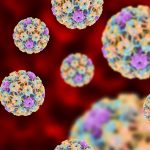Pediatric Environmental Allergies: A Case Study
Tolle Totum
Lisa Ghent, ND
Atopic diseases are a collection of problems that arise when the immune system has an exaggerated IgE-mediated response to what are normally harmless antigens.1 Atopic diseases include atopic dermatitis, allergic rhinitis, asthma, and food allergies, and are one of the most common reasons parents bring their kids to see me. Given the mild winter we’ve had in British Columbia this year, I’ve seen a lot of new patients for allergies, many of whom are children. It is always my goal to regulate the immune response as soon as possible in order to prevent the development of other atopic conditions.
The Patient
Parents are usually motivated to manage their children’s allergies naturally, given the alternatives, which include ignoring them, giving antihistamines daily, or – depending on the severity – initiating allergy shots.
Earlier this year I had a 7-year-old male present with complaints of enlarged tonsils, chronic rhinosinusitis, conjunctivitis, constipation, and low energy. While these issues had existed intermittently for a number of years, at the time of our appointment they had been consistently present for 2 months. Physical examination revealed enlarged tonsils and erythematous membranes of the ear canals bilaterally, as well as erythematous mucous membranes of both nostrils. There was no wheezing present. The patient’s nose continuously ran during the appointment, and he sneezed several times. While no rashes were evident, the patient reported itching over the entire body, especially at night when trying to fall asleep. There was a family history of allergies (extensive on his dad’s side) and eczema (patient’s brother). Mom had a history of ulcerative colitis and generally had difficulty with wheat. There were no family pets.
I performed allergy scratch-testing in-office, and he was positive for weeds, grasses, trees, dust, cats, dogs, and mold. The patient experienced significant pruritus during the test. While his mom had previously wondered about environmental allergies, she had never tried antihistamines.
Diet is Fundamental
The foundation of my approach to treating pediatric environmental allergies is the diet. There are well-documented cross-reactions between certain environmental allergies and specific foods, due to similarities in their protein structures.2 Upon review of the patient’s diet, I discovered that the majority of what he was eating can cause reactions based on his allergies. See Table 1 for a list of food cross-reactions with environmental allergens that I created based on various sources.3-5
Table 1. Allergen Cross-Reactions
| Allergen | Fruit | Vegetable | Other |
| Birch and alder trees | Apple (one of the most important foods to eliminate)
Pear Apricot Plum Peach Cherry Kiwi |
Carrot
Celery |
Hazelnut
Almond Soy Parsley |
| Grass | Tomatoes
Melons Peach Orange |
White potato
Celery Corn |
Wheat |
| Weeds | Melons
Peach Banana |
Carrot
Celery Zucchini Onion Leek Cabbage Broccoli Cauliflower Bell peppers Swiss chard |
Parsley
Caraway Fennel Coriander Aniseed Garlic Paprika Black pepper Mustard Peanuts Almonds Pistachio Chamomile Sunflower seeds |
| Dust | Shellfish | ||
| Ragweed | Melons
Banana |
Zucchini
Cucumber White potato |
Sunflower seeds |
A Comprehensive Approach
I recommend a 4-week elimination of the foods within the relevant categories, based on the allergy test results. I will suggest this approach even in the absence of oral allergy syndrome,3,4 due to the evidence that ties these foods to environmental allergies. If oral allergy syndrome does exist, my clinical experience has taught me to also include elimination of strawberry and blackberry.
Based on the test results for this patient, I asked Mom to remove all the dietary items listed in the chart. (Even though he wasn’t positive for ragweed, all of the related foods cross-react with other environmental allergies for which he did test positive). In this case, I also recommended eliminating dairy because of the constipation and chronic rhinosinusitis. Additionally, I requested that Mom increase the patient’s water consumption.
From a supplement perspective, I suggested 250 mg twice daily of a chewable vitamin C6 and a daily multi-strain, dairy-free probiotic. The vitamin C recommendation was for mast cell stabilization and antioxidant properties,7 and the probiotic was partly due to the chronic constipation and partly to assist with immune system modulation.8 Vitamin C and probiotics are both generally well tolerated by pediatric patients, and compliance issues are rare. Typically, I will also recommend cod liver oil for its vitamin A content and its role in decreasing inflammation9; however, in this case I decided against it, as I wasn’t sure if the patient had a fish allergy.
Because the action of histamine is cumulative, any reduction in exposure to allergens will help overall with symptoms and cross-reactions. This patient had a dust allergy, and so I counseled his mom on how to reduce dust in the home:
- Allergy covers on the bed mattress and pillows
- Removal of toys and clutter from the bedroom
- Minimal stuffed toys in the child’s bed
- Use of a HEPA air filter in the home
- Washing of all bedding once a week
- Dusting and vacuuming once a week, especially under the head of the child’s bed
- Replacement of wood-slat horizontal blinds with pull-down blinds in the bedroom
- Removal of any carpet in the bedroom and house if possible
- Smoke-free environment
- Regular cleaning of window sills throughout the home
- Examination of the home for any evidence of mold
- Windows kept closed as much as possible from spring through fall
The final treatment recommendation I made for this child was to use a daily xylitol nasal spray. A 2017 study showed that xylitol nasal irrigation resulted in a greater improvement in symptoms of chronic rhinosinusitis compared to using saline alone.10 Full nasal irrigations are very difficult to get a child to do; however, sprays are readily available, easy to administer, and are generally well tolerated by kids; in my experience, there is also a noticeable difference from using it. The 2017 study showed benefit after 30 days of use. My recommendation is to have children use it starting 1 month before their predicted allergy seasons and to continue it through to the end. In this case, the child might only have a break from the nasal spray for a few months out of the year; however, this is better than the alternative, which is to have them use a steroid-based spray.
I asked Mom to start keeping a record of both allergy symptoms and bowel movements so that we could gauge success of the treatments.
Follow-up
Mom and son returned to my office 9 weeks after their initial visit. They had been following the dietary recommendations, with very few exceptions, and had been fully compliant with the supplement suggestions. The nasal spraying was done daily, as was regular cleaning in the house. The boy’s room had been emptied of anything unnecessary.
What they had noticed is that the patient rarely complained about a sore stomach anymore. This wasn’t a primary complaint when they initially presented, but his mom commented that its absence was notable. Bowel movements were much more consistent, occurring, on average, 5 out of 7 days. Gas had noticeably decreased.
Mom estimated that there was a 75% reduction in allergic rhinitis, and an 80% reduction in pruritis. Her son was falling asleep sooner and more easily than before, and was not displaying any restlessness at bedtime. While Mom noticed an increase in his energy, it wasn’t consistent, so I decided to send them for blood work to check iron, vitamin B12, and thyroid function. At the time, the family had adapted well to the dietary changes, and noted that other family members had also experienced benefit. Thus, after discussing the options, we decided to keep going with the dietary eliminations for another couple of months. Mom felt satisfied with the results, and her son seemed comfortable enough to manage the remaining symptoms without any additional treatment. Supplement and nasal spray recommendations also remained the same.
Additional Allergy Treatments
Had the patient’s symptoms not improved as much as they did, I would have explored additional treatments. Here are additional suggestions for pediatric allergy management:
- Freeze-dried stinging nettle: 1-3 capsules BID-TID, depending on age, for children over 4 years old
- A safe and effective natural antihistamine that can dry out excess secretions
- Must be freeze-dried
- Is in capsule form, so the child must be able to swallow pills
- Quercetin: 150-250 mg daily for kids 5 years and older
- Mast cell stabilizer
- Best taken with vitamin C/mixed bioflavonoids
- Curcumin: 500 mg QD for ages 2-5 years old; 500 mg BID for ages 5-10 years old; and 1000 mg BID for over 10 years old
- Anti-inflammatory6
- Digestive enzymes:
- Especially helpful with allergic rhinosinusitis, to help break down proteins that are acting as triggers to the immune system
- Zinc: 5 mg QD for kids 2-5 years old; 10 mg QD for ages 5-10 years old; 15 mg QD for over 10 years old
- Supports respiratory and gut health
- Give with food (can cause nausea in children)
- Calcium magnesium: 125 mg BID
- Helps calm a hyperreactive nervous system
- Cod liver oil: Follow dosing on bottle, QD
- Anti-inflammatory
- N-acetylcysteine: 100 mg BID for children 12 years and older
- Antioxidant and mucolytic
- Acupressure of GB 20 (relieves congestion), the Four Gates (regulates the nervous system), LI 4 (relieves congestion), LI 11 (decreases severity of allergic symptoms), LI 20 (relieves congestion)11
- Dry brushing to increase lymphatic drainage
If you have the opportunity to counsel a mom before delivery, particularly one with a family history of atopic diseases, it is important to recommend a probiotic for a minimum of 4 weeks prior to delivery and 4 weeks after delivery (the mom) and up to age 6 months for the infant. The probiotic should include Lactobacillus rhamnosus strain GG (LGG), and ideally also Bifidobacterium lactis. Studies have shown a reduction of childhood eczema and, to a smaller degree, respiratory allergies.8
References:
- Moreno MA. JAMA Pediatrics Patient Page. Atopic Diseases in Children. JAMA Pediatr. 2016;170(1):96.
- American Academy of Allergy Asthma & Immunology. Food allergy. AAAAI Web site. https://www.aaaai.org/conditions-and-treatments/allergies/food-allergies. Accessed April 12, 2019.
- American Academy of Allergy Asthma & Immunology. Oral allergy syndrome (OAS) or pollen fruit syndrome (PFS). AAAAI Web site. https://www.aaaai.org/conditions-and-treatments/library/allergy-library/outdoor-food-allergies-relate. Accessed April 12, 2019.
- American College of Allergy, Asthma & Immunology. Oral allergy syndrome. Last updated March 21, 2019. ACAAI Web site. https://acaai.org/allergies/types/food-allergies/types-food-allergy/oral-allergy-syndrome. Accessed April 13, 2019.
- Popescu FD. Cross-reactivity between aeroallergens and food allergens. World J Methodol. 2015;5(2):31-50.
- Aviva Romm: Healthiest Kids University. Seasonal allergies and allergic rhinitis. Available at: https://healthiestkids.com/hay/. [Members access only] Accessed April 14, 2019.
- Vollbracht C, Raithel M, Krick B, et al. Intravenous vitamin C in the treatment of allergies: an interim subgroup analysis of a long-term observational study. J Int Med Res. 2018;46(9):3640-3655.
- Savilahti E. Probiotics in the treatment and prevention of allergies in children. Biosci Microflora. 2011;30(4):119-128.
- Dhanawat GS. Rhinitis, sinusitis and ocular disease – 2100. New approach to treat allergic rhinitis with Vitamin E, cod liver oil and Vitamin C with use of nasal steroidal World Allergy Organ J. 2013;6(Suppl 1):P175. Available at: https://www.ncbi.nlm.nih.gov/pmc/articles/PMC3643615/. Accessed April 13, 2019.
- Lin L, Tang X, Wei J, et al. Xylitol nasal irrigation in the treatment of chronic rhinosinusitis. Am J Otolaryngol. 2017;38(4):383-389.
- Zand J, Rountree R, Walton R, et al. Allergies. In: Smart Medicine for a Healthier Child. 2nd ed. New York, NY: Penguin Group Inc; 2003:115-119.
 Lisa Ghent, ND, is a naturopathic physician who graduated from the Boucher Institute of Naturopathic Medicine. Dr Ghent has a thriving family practice in Ladner, BC. She has a special interest and additional education in women’s health (fertility, OB/GYN, pre-/post-natal care) as well as pediatrics (including newborns). Another passion is mental health, particularly natural treatment of anxiety, depression, and insomnia. As a busy mom of 3, Dr Ghent understands the importance of balance in her practice. She primarily utilizes diet and lifestyle amendments, botanical medicine, nutritional supplementation, IV therapies, and acupuncture. Dr Ghent also holds prescriptive authority in the province of BC.
Lisa Ghent, ND, is a naturopathic physician who graduated from the Boucher Institute of Naturopathic Medicine. Dr Ghent has a thriving family practice in Ladner, BC. She has a special interest and additional education in women’s health (fertility, OB/GYN, pre-/post-natal care) as well as pediatrics (including newborns). Another passion is mental health, particularly natural treatment of anxiety, depression, and insomnia. As a busy mom of 3, Dr Ghent understands the importance of balance in her practice. She primarily utilizes diet and lifestyle amendments, botanical medicine, nutritional supplementation, IV therapies, and acupuncture. Dr Ghent also holds prescriptive authority in the province of BC.









